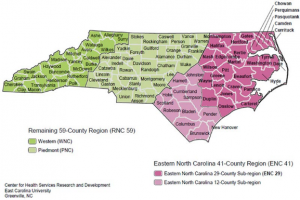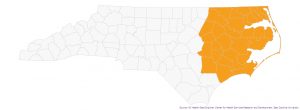WHERE WE SERVE
THE EASTERN NORTH CAROLINA 29 COUNTIES
The Lincoln Project recognizes that our communities, the places where we live, work, and play, have a profound impact on our health and well-being. Preventing premature death requires that we first analyze and understand the unique attributes of communities in eastern North Carolina. Specifically, the Lincoln researchers are committed to identifying the social, environmental, and medical drivers that influence health in the Eastern North Carolina 29 Counties, or the ENC-29.
Well known for health disparities, including disproportionately high mortality rates from cancers, cardiovascular diseases, and diabetes, the ENC-29 have become a popular focus of health and population research in North Carolina. These disparities are seen across all racial/ethnic, income, and education groups. These primarily rural counties are impacted disproportionately by Out of Hospital Premature Natural Death (OHPND) and present unique obstacles to improving health and well-being.

Those living in the ENC-29 have less consistent access to medical care and community resources. Social isolation and poverty can result in a lack of community support systems and poorer quality of life. Part of East Carolina’s mission is to devote resources to address health disparities in the ENC-29 through research, education, community programs, and training.
HOW HEALTHY IS YOUR COMMUNITY?
The Lincoln Project relies on programs such as the County Health Rankings and Roadmaps project developed by the University of Wisconsin Population Health Institute and the Robert Wood Johnson Foundation. Their 2018 report ranks North Carolina counties by health outcomes and health factors and identifies potential barriers to positive health outcomes including:
- Poverty
- Disparities in Education
- Poor Access to Health Insurance
- Lack of Social Connection
Counties in the ENC-29 are among the lowest performing when it comes to both health outcomes and health factors. The report highlights the need for increased health equity to prevent health disparities. This is a vital component of the Lincoln Project’s mission. Prevention of OHPND must incorporate addressing these and other barriers to health.
COUNTIES REPRESENTED IN THE ENC-29
Beaufort
Bertie
Camden
Carteret
Chowan
Craven
Currituck
Dare
Edgecombe
Gates
Greene
Halifax
Hertford
Hyde
Jones
Martin
Nash
Northampton
Onslow
Pamlico
Pasquotank
Perquimans
Tyrrell
Washington
Wayne
Wilson
BEHAVIORAL RISK FACTOR SURVEY
INTERACTIVE MAPS
The 2011 North Carolina Behavioral Risk Factor Surveillance Survey indicated a number of increased risk factors for those in the ENC-29 as compared to the rest of the state:
- Heart disease mortality is 12% greater
- Cancer (all sites) mortality is 5% greater
- Lung cancer mortality is 8% greater
- Diabetes mortality is 27% greater
- Stroke mortality is 5% greater
Interactive maps through the NC Health Data Explorer provide data on a wide range of health, social, and environmental factors across North Carolina.
